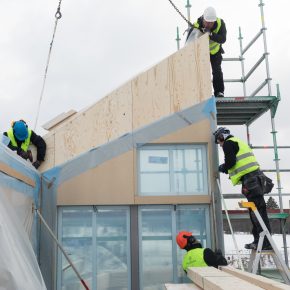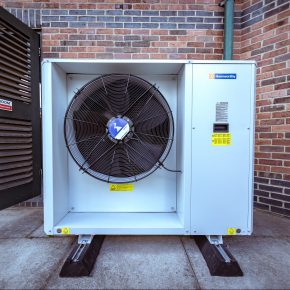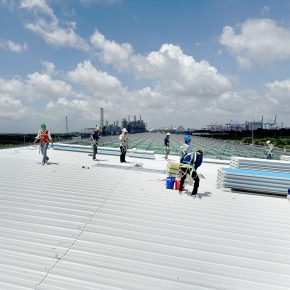
Six reasons why timber frame is surging in the UK – a Sodra article
 The mid-1980s saw plenty of negative press about quality control for timber-frame housing, which caused a healthy market to slump from around 40% to under 10% in a single year. Although slow to rebuild, recent years have seen a marked resurgence in the UK’s use of timber frame. Södra Wood Ltd‘s managing director Simon Henry has outlined six factors behind the trend…
The mid-1980s saw plenty of negative press about quality control for timber-frame housing, which caused a healthy market to slump from around 40% to under 10% in a single year. Although slow to rebuild, recent years have seen a marked resurgence in the UK’s use of timber frame. Södra Wood Ltd‘s managing director Simon Henry has outlined six factors behind the trend…
1) Sustainability – potential waiting to be unlocked
“Sustainability is not the main driving force behind the increased uptake of timber-frame construction in the UK, although perhaps it should be.
The focus in construction sustainability at present is on the impact of the building when it is in use. With its energy-efficient credentials, timber frame has a strong advantage in this respect, but where it also scores, and with considerably more positive impact, is the reduced carbon footprint and materials sustainability of the build itself when timber-frame is used.
With the potential growing awareness of sustainability in building regulations, this is likely to add weight to the timber-frame argument.
2) Speed of construction
Speed of construction is another motivation to build with timber frame. There is still a perception that timber frame is more expensive than brick and block.
However, factors such as speed of construction and reduced foundation requirement bring down the overall cost, as builders are discovering.
This aspect also means far less disruption in the local community if the build is in a built-up area, and easier delivery of materials if the site is isolated.
3) Specification – better, more flexible
It is easier to produce a higher-specification house with timber frame – to create thicker, better insulated walls for example or even a passive house.
Wider use of I joists with their strength and stability is, while not new, another aspect which has increased the benefit of timber in construction (Södra Wood Ltd has an exclusive arrangement with Masonite for the supply of I joists).
Timber also offers more flexibility for new-build home buyers to specify details such as room sizes and layout, rather than just carpets and fittings.

4) Innovation
While the structure of timber-frame houses might look very similar to 40 years ago, there has been real innovation in terms of the final building’s comfort and efficiency, including insulation, vapour barriers and draft control.
The package delivered to the building site has evolved significantly. Hybrid solutions of timber and metal – metal web – are also on the rise, offering office developers, for example, the opportunity to incorporate timber where wide span, cable/pipe-accessible floors are required.
5) The ideal solution
Timber frame is ideal for traditional family homes but timber frame and composites such as CLT have really caught the imagination for specific sectors such as social housing, key-worker/student accommodation and roof-top extensions.
Social housing providers are attracted by reduced post-construction snagging and lower running costs for residents in terms of energy.
For key-worker and student accommodation, the possibilities with volumetric or modular construction are the big draw.
Timber-frame/CLT construction, for example, allows the completion of individual modules in the factory, which can then be stacked together on site with remarkable speed to create high-quality, efficient accommodation.
Where space is at a premium, developers can create greater space within a building’s existing footprint by building on the roof. Timber frame is perfect for this because of its significantly lighter weight than brick and block.
6) The shortage of on-site building skills
Builders struggle to recruit some of the traditional trades to building sites owing to a shortage of skills. This means the ability to assemble much of a house’s structure off-site is an attractive benefit of timber-frame housing, as is the quality control which goes with increasingly systemised, automated off-site solutions.”
Address: Södra Wood Ltd, Unit 18/19, Cirencester Office Park, Tetbury Road, Cirencester GL7 6JJ
Phone: +44 (0)1285 646000
Fax: +44 (0)1285 646020
Email: [email protected]
Visit Supplier's page
Latest news

18th April 2024
MRA appoints Callum Budd as Research Projects Director
MRA Research, the research agency focused solely on the construction sector, welcomes Callum Budd as its new Research Projects Director.
Posted in Articles, Building Industry News, Information Technology, news, Recruitment, Research & Materials Testing
16th April 2024
Mitsubishi Electric set to host CIBSE Journal webinar
Mitsubishi Electric will host a CIBSE Journal webinar on Wednesday 24th April 2024 at 1pm to discuss the legislation and initiatives driving changes in the way we will need to heat, cool and ventilate large commercial buildings to reach net zero emissions in the UK.
Posted in Air Conditioning, Articles, Building Industry Events, Building Industry News, Building Products & Structures, Building Regulations & Accreditations, Building Services, Facility Management & Building Services, Heating Systems, Controls and Management, Heating, Ventilation and Air Conditioning - HVAC, Information Technology, Pipes & Fittings, Plumbing, Seminars, Sustainability & Energy Efficiency, Training
16th April 2024
Hamworthy: What to consider when choosing a heat pump?
At the heart of an efficient heat pump system lies an important element: the refrigerant – Jason Allen, Commercial Product Manager, Groupe Atlantic UK, ROI & NA. Hamworthy Heating is a Groupe Atlantic brand.
Posted in Articles, Building Industry News, Building Products & Structures, Building Services, Facility Management & Building Services, Heating Systems, Controls and Management, Heating, Ventilation and Air Conditioning - HVAC, Pipes & Fittings, Plumbing, Retrofit & Renovation, Sustainability & Energy Efficiency
15th April 2024
EJOT Colorfast chosen for Kingspan’s highly sustainable new Asian factory
More than 120,000 EJOT Colorfast self-drilling fasteners have helped Kingspan to create a thermally superior, visually-appealing building envelope for its first purpose-built manufacturing plant in South East Asia.
Posted in Articles, Building Industry News, Building Products & Structures, Building Systems, Case Studies, Posts, Restoration & Refurbishment, Retrofit & Renovation, Roofs, Sustainability & Energy Efficiency
 Sign up:
Sign up: